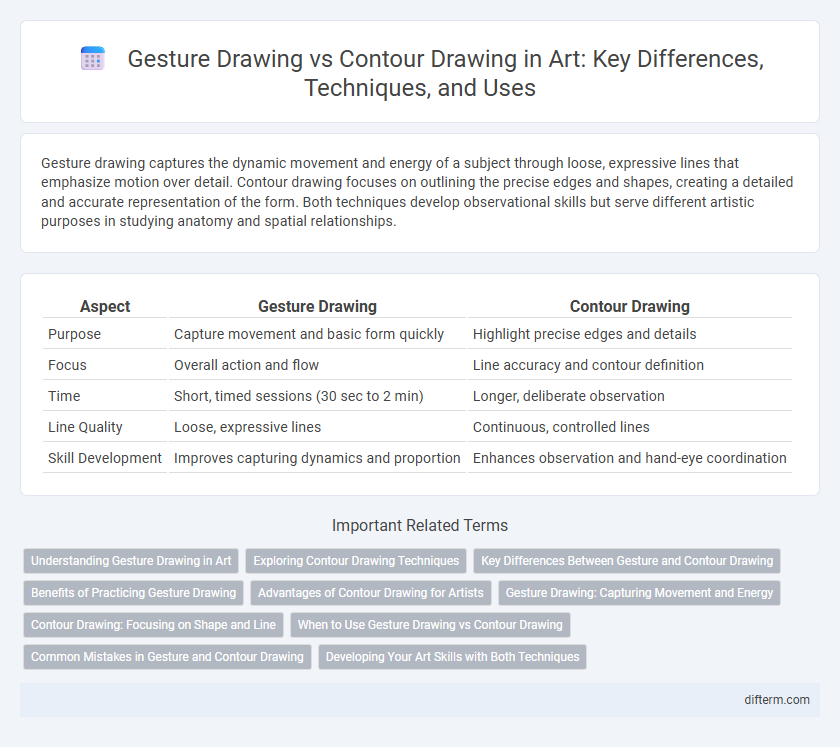Gesture drawing captures the dynamic movement and energy of a subject through loose, expressive lines that emphasize motion over detail. Contour drawing focuses on outlining the precise edges and shapes, creating a detailed and accurate representation of the form. Both techniques develop observational skills but serve different artistic purposes in studying anatomy and spatial relationships.
Table of Comparison
| Aspect | Gesture Drawing | Contour Drawing |
|---|---|---|
| Purpose | Capture movement and basic form quickly | Highlight precise edges and details |
| Focus | Overall action and flow | Line accuracy and contour definition |
| Time | Short, timed sessions (30 sec to 2 min) | Longer, deliberate observation |
| Line Quality | Loose, expressive lines | Continuous, controlled lines |
| Skill Development | Improves capturing dynamics and proportion | Enhances observation and hand-eye coordination |
Understanding Gesture Drawing in Art
Gesture drawing captures the movement and essence of a subject through quick, fluid strokes that emphasize action over detail, making it essential for studying human anatomy and dynamic poses. This technique trains artists to observe the underlying motion and energy, improving their ability to depict life and spontaneity in their work. Unlike contour drawing, which focuses on precise outlines, gesture drawing prioritizes rhythm and flow to convey the subject's vitality.
Exploring Contour Drawing Techniques
Contour drawing techniques emphasize capturing the edges and surface ridges of a subject, enhancing an artist's observational skills and hand-eye coordination. Unlike gesture drawing, which prioritizes movement and energy, contour drawing focuses on precise line work to define shapes and details. Mastering contour drawing improves the ability to render form and texture accurately, creating more lifelike representations in art.
Key Differences Between Gesture and Contour Drawing
Gesture drawing emphasizes capturing the movement and overall form of a subject rapidly, focusing on action and fluidity. Contour drawing concentrates on outlining the edges and details with deliberate, continuous lines to define shape and structure accurately. Gesture drawing prioritizes expression and dynamism, while contour drawing aims for precision and meticulous observation.
Benefits of Practicing Gesture Drawing
Practicing gesture drawing enhances an artist's ability to capture the essence and movement of a subject quickly, promoting fluidity and expression in artwork. It strengthens observation skills, allowing for better understanding of body mechanics and spatial relationships. This dynamic drawing exercise also improves hand-eye coordination, essential for creating lively and proportionate compositions.
Advantages of Contour Drawing for Artists
Contour drawing enhances artists' observational skills by emphasizing the precise outline and structure of subjects, fostering a deeper understanding of form and spatial relationships. This technique promotes hand-eye coordination, improving control and dexterity essential for detailed work. By focusing on continuous lines, contour drawing encourages artists to capture the essence of shapes and proportions accurately, laying a strong foundation for more complex artistic endeavors.
Gesture Drawing: Capturing Movement and Energy
Gesture drawing emphasizes capturing the fluidity and dynamism of a subject's movement, using quick, expressive strokes to convey energy rather than fine details. This technique allows artists to depict the essence of motion and posture within seconds, promoting a more instinctive and emotional connection to the figure. By prioritizing rhythm and flow, gesture drawing fosters a deeper understanding of human anatomy and spatial relationships, enhancing overall artistic expression.
Contour Drawing: Focusing on Shape and Line
Contour drawing emphasizes capturing the precise shape and line quality of a subject, highlighting its form through continuous, deliberate strokes. This technique enhances an artist's observational skills by requiring close attention to detail and the edges that define the object's boundaries. Unlike gesture drawing, which prioritizes movement and energy, contour drawing concentrates on creating accurate, clean outlines to represent the subject's structure.
When to Use Gesture Drawing vs Contour Drawing
Use gesture drawing when capturing the essence and movement of a subject quickly, emphasizing dynamic poses and fluidity. Contour drawing suits detailed observation of edges and shapes, ideal for studying intricate details and form accuracy. Gesture drawing is effective in initial stages of artwork, while contour drawing enhances precision during refinement.
Common Mistakes in Gesture and Contour Drawing
Common mistakes in gesture drawing often include overly rigid lines and excessive detail, which hinder capturing the fluidity and motion of the subject. In contour drawing, errors frequently involve lifting the pen too much and losing focus on continuous observation, resulting in disconnected or inaccurate outlines. Both techniques demand practice in maintaining loose, confident strokes to enhance expressiveness and accuracy.
Developing Your Art Skills with Both Techniques
Gesture drawing enhances the ability to capture movement and fluidity, focusing on the essence of a subject's pose within seconds. Contour drawing sharpens observational skills by emphasizing precise lines and edges, helping artists understand shapes and boundaries. Combining both techniques accelerates artistic development, offering a balance between dynamic expression and detailed study.
gesture drawing vs contour drawing Infographic

 difterm.com
difterm.com